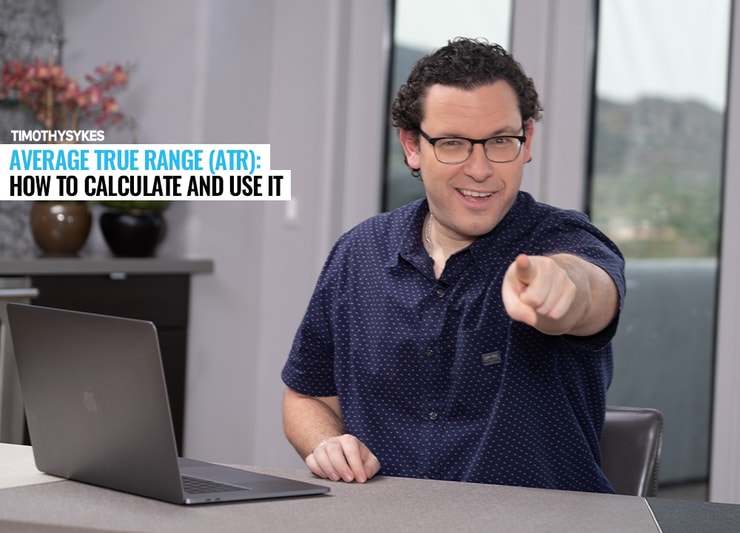I like trading stocks with a high average true range (ATR). What does that mean?
It means I don’t trade stocks that move 50 cents in a day … I trade stocks that move 50 cents in a few minutes. My goal is to make 10% a trade, not 10% a year, like most average long-term investors.
So, how do you find stocks that have the potential for big moves? One way is to calculate a stock’s average true range.
Let’s get into how to calculate a stock’s ATR and how you can use it to improve your trading…
Table of Contents
- 1 What’s Average True Range (ATR)?
- 2 What’s ATR Used For?
- 3 How Can Average True Range Improve Your Trading?
- 4 How Is the Average True Range Calculated?
- 5 Average True Range vs. Standard Deviation
- 6 Average True Range vs. Bollinger Bands®
- 7 How to Use Average True Range on Your Trades
- 8 What Are the Limitations of Using Average True Range?
- 9 Conclusion
What’s Average True Range (ATR)?

Average true range (ATR) is a technical trading indicator. It’s an average of a stock’s true range over a specific time frame, usually 14 days.
You can calculate ATR over any length of time, depending on how long you plan to hold your position.
What’s ATR Used For?
The average true range indicator was designed for the commodities market. But traders now use it for stocks, indices, and forex.
Its main purpose is to measure the volatility of a stock. If a stock’s ATR is a high number, then it’s a highly volatile stock. If its ATR is low, it’s less volatile.
ATR can give you an idea of the kinds of price movements you can expect to see from a stock in an average trading day.
How Can Average True Range Improve Your Trading?
I like trading volatile stocks — stocks with high average true range. That’s one way I can take a tiny piece of a move and still make a profit of more than $6 million* over my 20+ years of trading penny stocks.
(*Please note that these kinds of trading results are not typical. Most traders lose money. It takes years of dedication, hard work, and discipline to learn how to trade, and individual results will vary. Trading is inherently risky. Before making any trades, remember to do your due diligence and never risk more than you can afford to lose.)
ATR can improve your trading by giving you an idea of how volatile a stock is.
I teach my students to embrace volatility — it can be a trader’s best friend. It can be a good way to potentially profit from big price moves in a short period of time. But it can be like playing with fire. You have to play safe.
Volatility can turn on you at any second and can burn you on the way down — badly. That’s why rule #1 is to always cut losses quickly.
ATR can also help you find the right position size for a trade, where to cut losses, and a potential profit target. I’ll get into that more later on…
I want to help you learn how to trade volatile sectors and volatile stocks. There can be some great opportunities there. Check out my no-cost “Volatility Survival Guide” for tips on trading volatility.
How Is the Average True Range Calculated?
To calculate the ATR, you need to know the true range. Then you can divide that over the number of days you want to average.
You can calculate a stock’s daily range by subtracting the day’s low from the day’s high. The true range is a little different since it calculates the range from the previous day’s closing price … if it’s outside the next day’s trading range.
True range is the highest of these three calculations:
- The day’s high minus the day’s low
- The day’s high minus the previous day’s close
- The day’s low minus the previous day’s close
The average true range indicator totals the true range of each day and divides it over the tracking period to get the average.
You can also calculate ATR on a platform like Python or TradingView.
How Do You Find Average True Range in Excel?
You can calculate ATR in Excel to make it a little easier on yourself. You’ll have to manually track a stock’s true daily range by entering the date and time, open and close, and high and low of each day into a spreadsheet.
Once that’s done, you can use Excel’s MAX function along with a simple formula to find the highest of the three calculations. Then you can use the SUM function with a formula to divide the sum over the number of days you’re tracking.
Average True Range vs. Standard Deviation
Standard deviation is a less common way to calculate volatility. ATR and standard deviation both use a time frame of a couple of weeks to get the most accurate numbers. The purpose of both is to determine a number to summarize the price movement of a stock.
Average true range uses the true range from the closing price, as well as the highs and lows, to calculate a stock’s average movement. Standard deviation generally only uses closing prices.
So, you could say ATR is a more accurate calculation for the true range of a stock.
Average True Range vs. Bollinger Bands®
Bollinger Bands® are a set of lines plotting out the range a stock’s likely to move within. They’re a tool available on StocksToTrade and other trading and charting platforms.
If the range of the bands is close together, then the stock isn’t moving very much that day. If the bands are far apart, the stock might see price swings. This could mean the stock has a high ATR or high volatility.
Bollinger Bands and ATR don’t tell you which way a stock will move. They only provide an estimate and an average of the stock’s potential range and volatility.
How to Use Average True Range on Your Trades
ATR can give you an idea of how much a stock might move on any given day. Since it’s an average, there’ll be times the stock will move more and times it will move less.
I trade based on news catalysts and patterns, so ATR doesn’t really fit my style. That’s because penny stocks can go full supernova on the right news. Supernovas can have gains of as much as 500%…
These huge percent gainers are outside any stock’s average true range. And these huge percent gainers are exactly why I love penny stocks. It’s how I profit while still trading scared and only holding positions for a few minutes.*
Sign up for my Supernova Alerts to get notified before a penny stock goes supernova. But don’t use my alerts just to enter a trade. Use them to learn how to recognize these types of plays so you can become a self-sufficient trader.
Let’s go into more detail about how the ATR indicator can be used in your trading…
How Do You Read an ATR Indicator?
The ATR indicator will display on your trading platform like a line chart. The best trading platform, in my opinion, is StocksToTrade.
(Full disclosure: I helped develop StocksToTrade and I’m a major investor. That said, it’s my dream stock-scanning tool. It’s designed to help save time in finding the best stocks that fit my patterns and strategy.)
StocksToTrade has charting tools, built-in watchlists, and the amazing new Breaking News Chat. Check out the 14-day trial of StocksToTrade for $7. Get it with the Breaking News Chat for $17.
Anyway, back to ATR … The indicator on your platform will move up during times of high ATR, or high volatility, and it will be low when ATR or volatility is low.
So if you want to trade volatile stocks the way I do, you’ll want to look for stocks with the ATR near the top of the range.
The indicator will change based on the chart time frame you’ve set up. If you’re looking at a one-minute chart, the ATR shows you the average range per minute. On a daily chart, it’s showing you the average range per day.
More Breaking News
- Is SoFi on the Verge of a Major Makeover?
- Templeton Trust’s Stock Surge: What’s Behind the Recent Momentum?
- Quantum Leap: Is IonQ’s Stock Set to Skyrocket?
Sizing a Futures Trade Using Average True Range
ATR can help you calculate your position size for any given trade. Remember, a stock with a high ATR is more volatile.
So if your entry is far from your stop loss, you should be using a smaller position size to keep your losses under control.
But if a stock has a low ATR, your stop loss can be tighter and you may be able to use a larger position size.
Remember to keep volume in mind when choosing your position size. You can’t take a large position in a stock with low volume. You could be stuck with a bunch of shares with no buyers when you want to sell.
How to Use Average True Range to Set a Stop Loss
ATR can also help you know where to place your stop loss or find an area to cut your loss.
If you’re trading a stock with a high ATR, your stop loss will probably be wider, since the stock will have more volatile price swings throughout the day.
That’s why I prefer mental stops as opposed to hard stop losses. If I don’t like the price action, I just get out, and I suggest you do the same. I don’t have to wait until the stock goes all the way down to my stop loss. And my order isn’t sitting there for market makers to take advantage of it.
To use mental stops, you have to be disciplined enough to accept when you’re wrong and cut your losses.
You’ll have to set your stop loss and use a position size that fits your risk-management strategy. Longer-term investors usually set a stop loss one day’s average true range from the entry. If you’re day trading, you’ll have to determine your stop loss based on the intraday volatility of the stock and your risk tolerance.
ATR can also give you an idea of a potential profit target. If there’s no news driving a stock’s price higher and bringing in more volume, you have an idea of where you could sell when the stock reaches its range for the day.
You can also use ATR to rule out trades. If a stock has already moved more than its average day’s range, there might not be potential for a trade.
What Are the Limitations of Using Average True Range?
There’s no perfect indicator that tells you when to trade and when not to. You have to combine ATR with other indicators and signals before taking a trade.
Just because a stock usually moves $1 in a day doesn’t mean you enter at the open and hold until it’s moved $1. And on the flip side, if the stock has already moved $1, that doesn’t mean you short it, thinking it has no more room to go up.
Trading’s not that easy.
You need a strategy with your own buy signals. You can combine your strategy with other indicators to see if they all line up to point to a good trading opportunity.
I teach my students my trading strategy in my Trading Challenge. Apply today if you want to put in the time and effort to learn more.
My “Trader Checklist Part Deux” DVD (included as part of the Trading Challenge) goes over all the indicators I take into account before placing a trade.
Some of my indicators don’t have anything to do with the stock market. Trading’s a lot of you vs. you. You have to learn how to manage emotions and other outside factors that can affect your trading.
Conclusion
ATR is a trading indicator that can give you an idea of how much a stock will move in a day based on the stock’s past movements.
I don’t use a lot of chart indicators in my trading. I stick to simple support and resistance levels and price action.
I don’t stay in a trade very long, and I’m usually trading on some kind of news catalyst that’s moving the stock. Once news breaks, the stock’s previous price movements don’t really matter. Because news and hype can drive stocks higher than you think.
A huge price move on a news release can cause a short squeeze that drives prices even higher.
If you want to learn how to trade volatile penny stocks, apply for my Trading Challenge. You’ll get access to my chat room, DVDs, video lessons, and live weekly webinars.
I teach the repeatable patterns I’ve learned from my 20+ years in the market.
Do you use an average true range indicator? Leave a comment and let me know!






Leave a reply